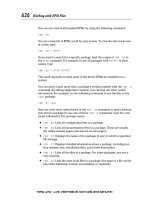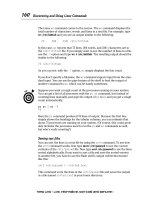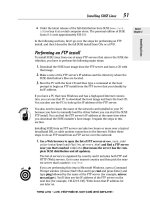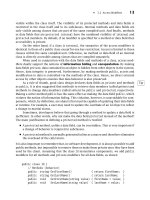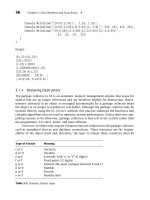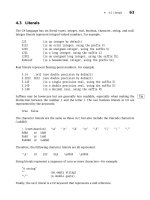TCP/IP Sockets in C# Practical Guide for Programmers phần 7 pdf
Bạn đang xem bản rút gọn của tài liệu. Xem và tải ngay bản đầy đủ của tài liệu tại đây (107.51 KB, 19 trang )
102 Chapter 4: Beyond the Basics
■
28 }
29 }
30
31 class ThreadExample {
32
33 static void Main(string[] args) {
34
35 MyThreadClass mtc1 = new MyThreadClass("Hello");
36 new Thread(new ThreadStart(mtc1.runMyThread)).Start();
37
38 MyThreadClass mtc2 = new MyThreadClass("Aloha");
39 new Thread(new ThreadStart(mtc2.runMyThread)).Start();
40
41 MyThreadClass mtc3 = new MyThreadClass("Ciao");
42 new Thread(new ThreadStart(mtc3.runMyThread)).Start();
43 }
44 }
ThreadExample.cs
1. MyThreadClass: lines 3–29
In order to pass state to the method we will be running as its own thread, we put the
method in its own class, and pass the state variables in the class constructor. In this
case the state is the string greeting to be printed.
■
Constructor: lines 13–15
Each instance of ThreadExample contains its own greeting string.
■
Initialize an instance of Random(): line 18
Used to generate a random number of sleep times.
■
for loop: line 20
Loop 10 times.
■
Print the thread id and instance greeting: lines 21–22
The static method Thread.CurrentThread.GetHashCode() returns a unique id
reference to the thread from which it is called.
■
Suspend thread: lines 24–26
After printing its instance’s greeting message, each thread sleeps for a random
amount of time (between 0 and 500 milliseconds) by calling the static method
Thread.Sleep(), which takes the number of milliseconds to sleep as a parameter.
The rand.Next(500) call returns a random int between 0 and 500. Thread.Sleep()
can be interrupted by another thread, in which case ThreadInterruptedException
is thrown. Our example does not include an interrupt call, so the exception will
not happen in this application.
■
4.3 Threads 103
2. Main(): lines 33–43
Each of the three groupings of statements in Main() does the following: (1) creates
a new instance of MyThreadClass with a different greeting string; (2) passes the
runMyThread() method of the new instance to the constructor of ThreadStart;
(3) passes the ThreadStart instance to the constructor of Thread; and (4) calls the
new Thread instance’s Start() method. Each thread independently executes the
runMyThread() method of ThreadExample, while the Main() thread terminates.
Upon execution, an interleaving of the three greeting messages is printed to the
console. The exact interleaving of the numbers depends upon the factors mentioned
earlier.
4.3.1 Server Protocol
Since the two server approaches we are going to describe (thread-per-client and thread
pool) are independent of the particular client-server protocol, we want to be able to use
the same protocol code for both. In order to make the protocol used easily extensible, the
protocol classes will implement the IProtocol interface, defined in IProtocol.cs. This
simple interface has only one method, handleclient(), which has no arguments and a
void return type.
IProtocol.cs
0 public interface IProtocol {
1 void handleclient();
2 }
IProtocol.cs
The code for the echo protocol is given in the class EchoProtocol, which encapsu-
lates the implementation of the server side of the echo protocol. The idea is that the
server creates a separate instance of EchoProtocol for each connection, and protocol
execution begins when handleclient() is called on an instance. The code in handle-
client() is almost identical to the connection handling code in TcpEchoServer.cs, except
that a logging capability (described shortly) has been added. We can create a thread that
independently executes handleclient(), or we can invoke handleclient() directly.
EchoProtocol.cs
0 using System.Collections; // For ArrayList
1 using System.Threading; // For Thread
2 using System.Net.Sockets; // For Socket
104 Chapter 4: Beyond the Basics
■
3
4 class EchoProtocol : IProtocol {
5 public const int BUFSIZE = 32; // Byte size of IO buffer
6
7 private Socket clntSock; // Connection socket
8 private ILogger logger; // Logging facility
9
10 public EchoProtocol(Socket clntSock, ILogger logger) {
11 this.clntSock = clntSock;
12 this.logger = logger;
13 }
14
15 public void handleclient() {
16 ArrayList entry = new ArrayList();
17 entry.Add("Client address and port="+clntSock.RemoteEndPoint);
18 entry.Add("Thread="+Thread.CurrentThread.GetHashCode());
19
20 try {
21 // Receive until client closes connection, indicated by a SocketException
22 int recvMsgSize; // Size of received message
23 int totalBytesEchoed = 0; // Bytes received from client
24 byte[] rcvBuffer = new byte[BUFSIZE]; // Receive buffer
25
26 // Receive untl client closes connection, indicated by 0 return code
27 try {
28 while ((recvMsgSize = clntSock.Receive(rcvBuffer, 0, rcvBuffer.Length,
29 SocketFlags.None)) > 0) {
30 clntSock.Send(rcvBuffer, 0, recvMsgSize, SocketFlags.None);
31 totalBytesEchoed += recvMsgSize;
32 }
33 } catch (SocketException se) {
34 entry.Add(se.ErrorCode + ": " + se.Message);
35 }
36
37 entry.Add("Client finished; echoed " + totalBytesEchoed + " bytes.");
38 } catch (SocketException se) {
39 entry.Add(se.ErrorCode + ": " + se.Message);
40 }
41
42 clntSock.Close();
43
44 logger.writeEntry(entry);
■
4.3 Threads 105
45 }
46 }
EchoProtocol.cs
1. Member variables and constructor: lines 5–13
Each instance of EchoProtocol contains a client socket for the connection and a
reference to the logger.
2. handleclient(): lines 15–45
Handle a single client:
■
Write the client and thread information to the log: lines 16–18
ArrayList is a dynamically sized container of Objects. The Add() method of
ArrayList inserts the specified object at the end of the list. In this case, the
inserted object is a String. Each element of the ArrayList represents a line of
output to the logger.
■
Execute the echo protocol: lines 20–42
■
Write the elements (one per line) of the ArrayList instance to the logger:
line 44
The logger allows for synchronized reporting of thread creation and client comple-
tion, so that entries from different threads are not interleaved. This facility is defined by
the ILogger interface, which has methods for writing strings or object collections.
ILogger.cs
0 using System; // For String
1 using System.Collections; // For ArrayList
2
3 public interface ILogger {
4 void writeEntry(ArrayList entry); // Write list of lines
5 void writeEntry(String entry); // Write single line
6 }
ILogger.cs
writeEntry() logs the given string or object collection. How it is logged depends on
the implementation. One possibility is to send the log messages to the console.
ConsoleLogger.cs
0 using System; // For String
1 using System.Collections; // For ArrayList
106 Chapter 4: Beyond the Basics
■
2 using System.Threading; // For Mutex
3
4 class ConsoleLogger : ILogger {
5 private static Mutex mutex = new Mutex();
6
7 public void writeEntry(ArrayList entry) {
8 mutex.WaitOne();
9
10 IEnumerator line = entry.GetEnumerator();
11 while (line.MoveNext())
12 Console.WriteLine(line.Current);
13
14 Console.WriteLine();
15
16 mutex.ReleaseMutex();
17 }
18
19 public void writeEntry(String entry) {
20 mutex.WaitOne();
21
22 Console.WriteLine(entry);
23 Console.WriteLine();
24
25 mutex.ReleaseMutex();
26 }
27 }
ConsoleLogger.cs
Another possibility is to write the log messages to a file specified in the constructor,
as in the following example.
FileLogger.cs
0 using System; // For String
1 using System.IO; // For StreamWriter
2 using System.Threading; // For Mutex
3 using System.Collections; // For ArrayList
4
5 class FileLogger : ILogger {
6 private static Mutex mutex = new Mutex();
7
■
4.3 Threads 107
8 private StreamWriter output; // Log file
9
10 public FileLogger(String filename) {
11 // Create log file
12 output = new StreamWriter(filename, true);
13 }
14
15 public void writeEntry(ArrayList entry) {
16 mutex.WaitOne();
17
18 IEnumerator line = entry.GetEnumerator();
19 while (line.MoveNext())
20 output.WriteLine(line.Current);
21 output.WriteLine();
22 output.Flush();
23
24 mutex.ReleaseMutex();
25 }
26
27 public void writeEntry(String entry) {
28 mutex.WaitOne();
29
30 output.WriteLine(entry);
31 output.WriteLine();
32 output.Flush();
33
34 mutex.ReleaseMutex();
35 }
36 }
FileLogger.cs
In each example the System.Threading.Mutex class is used to guarantee that only one
thread is writing at one time.
We are now ready to introduce some different approaches to concurrent servers.
4.3.2 Thread-per-Client
In a thread-per-client server, a new thread is created to handle each connection. The
server executes a loop that runs forever, listening for connections on a specified port
108 Chapter 4: Beyond the Basics
■
and repeatedly accepting an incoming connection from a client, and then spawning a new
thread to handle that connection.
TcpEchoServerThread.cs implements the thread-per-client architecture. It is very
similar to the iterative server, using a single indefinite loop to receive and process client
requests. The main difference is that it creates a thread to handle the connection instead
of handling it directly.
TcpEchoServerThread.cs
0 using System; // For Int32, ArgumentException
1 using System.Threading; // For Thread
2 using System.Net; // For IPAddress
3 using System.Net.Sockets; // For TcpListener, Socket
4
5 class TcpEchoServerThread {
6
7 static void Main(string[] args) {
8
9 if (args.Length != 1) // Test for correct # of args
10 throw new ArgumentException("Parameter(s): <Port>");
11
12 int echoServPort = Int32.Parse(args[0]); // Server port
13
14 // Create a TcpListener socket to accept client connection requests
15 TcpListener listener = new TcpListener(IPAddress.Any, echoServPort);
16
17 ILogger logger = new ConsoleLogger(); // Log messages to console
18
19 listener.Start();
20
21 // Run forever, accepting and spawning threads to service each connection
22 for (;;) {
23 try {
24
Socket clntSock = listener.AcceptSocket(); // Block waiting for connection
25 EchoProtocol protocol = new EchoProtocol(clntSock, logger);
26 Thread thread = new Thread(new ThreadStart(protocol.handleclient));
27 thread.Start();
28
logger.writeEntry("Created and started Thread="+thread.GetHashCode());
29 } catch (System.IO.IOException e) {
30 logger.writeEntry("Exception="+e.Message);
31 }
32 }
■
4.3 Threads 109
33 /* NOT REACHED */
34 }
35 }
TcpEchoServerThread.cs
1. Parameter parsing and server socket/logger creation: lines 9–19
2. Loop forever, handling incoming connections: lines 21–33
■
Accept an incoming connection: line 24
■
Create a protocol instance to handle new connection: line 25
Each connection gets its own instance of EchoProtocol. Each instance maintains
the state of its particular connection. The echo protocol has little internal state,
but more sophisticated protocols may require substantial amounts of state.
■
Create, start, and log a new thread for the connection: lines 26–28
Since EchoProtocol implements a method suitable for execution as a thread
(handleclient() in this case, a method that takes no parameters and returns
void), we can give our new instance’s thread method to the ThreadStart con-
structor, which in turn is passed to the Thread constructor. The new thread will
execute the handleclient() method of EchoProtocol when Start() is invoked.
The GetHashCode() method of the static Thread.CurrentThread property returns
a unique id number for the new thread.
■
Handle exception from AcceptSocket(): lines 29–31
If some I/O error occurs, AcceptSocket() throws a SocketException. In our earlier
iterative echo server (TcpEchoServer.cs), the exception is not handled, and such
an error terminates the server. Here we handle the exception by logging the error
and continuing execution.
4.3.3 Factoring the Server
Our threaded server does what we want it to, but the code is not very reusable or extensi-
ble. First, the echo protocol is hard-coded in the server. What if we want an HTTP server
instead? We could write an HTTPProtocol and replace the instantiation of EchoProtocol in
Main(); however, we would have to revise Main() and have a separate main class for each
different protocol that we implement.
We want to be able to instantiate a protocol instance of the appropriate type for
each connection without knowing any specifics about the protocol, including the name
of a constructor. This problem—instantiating an object without knowing details about its
type—arises frequently in object-oriented programming, and there is a standard solution:
use a factory. A factory object supplies instances of a particular class, hiding the details
of how the instance is created, such as what constructor is used.
110 Chapter 4: Beyond the Basics
■
For our protocol factory, we define the IProtocolFactory interface to have a single
method, createProtocol(), which takes Socket and ILogger instances as arguments and
returns an instance implementing the desired protocol. Our protocols will all implement
the handleclient() method, so we can run them as their own Thread to execute the pro-
tocol for that connection. Thus, our protocol factory returns instances that implement the
handleclient() method:
IProtocolFactory.cs
0 using System.Net.Sockets; // For Socket
1
2 public interface IProtocolFactory {
3 IProtocol createProtocol(Socket clntSock, ILogger logger);
4 }
IProtocolFactory.cs
We now need to implement a protocol factory for the echo protocol. The factory class
is simple. All it does is return a new instance of EchoProtocol whenever createProtocol()
is called.
EchoProtocolFactory.cs
0 using System.Net.Sockets; // For Socket
1
2 public class EchoProtocolFactory : IProtocolFactory {
3 public EchoProtocolFactory() {}
4
5 public IProtocol createProtocol(Socket clntSock, ILogger logger) {
6 return new EchoProtocol(clntSock, logger);
7 }
8 }
EchoProtocolFactory.cs
We have factored out some of the details of protocol instance creation from our
server, so that the various iterative and concurrent servers can reuse the protocol code.
However, the server approach (iterative, thread-per-client, etc.) is still hard-coded in
Main(). These server approaches deal with how to dispatch each connection to the appro-
priate handling mechanism. To provide greater extensibility, we want to factor out the
dispatching model from the Main() of TcpEchoServerThread.cs so that we can use any
■
4.3 Threads 111
dispatching model with any protocol. Since we have many potential dispatching mod-
els, we define the IDispatcher interface to hide the particulars of the threading strategy
from the rest of the server code. It contains a single method, startDispatching(), which
tells the dispatcher to start handling clients accepted via the given TcpListener, creating
protocol instances using the given IProtocolFactory, and logging via the given ILogger.
IDispatcher.cs
0 using System.Net.Sockets; // For TcpListener
1
2 public interface IDispatcher {
3 void startDispatching(TcpListener listener, ILogger logger,
4 IProtocolFactory protoFactory);
5 }
IDispatcher.cs
To implement the thread-per-client dispatcher, we simply pull the for loop from
Main() in TcpEchoServerThread.cs into the startDispatching() method of the new dis-
patcher. The only other change we need to make is to use the protocol factory instead of
instantiating a particular protocol.
ThreadPerDispatcher.cs
0 using System.Net.Sockets; // For TcpListener, Socket
1 using System.Threading; // For Thread
2
3 class ThreadPerDispatcher : IDispatcher {
4
5 public void startDispatching(TcpListener listener, ILogger logger,
6 IProtocolFactory protoFactory) {
7
8 // Run forever, accepting and spawning threads to service each connection
9
10 for (;;) {
11 try {
12 listener.Start();
13
Socket clntSock = listener.AcceptSocket(); // Block waiting for connection
14 IProtocol protocol = protoFactory.createProtocol(clntSock, logger);
15 Thread thread = new Thread(new ThreadStart(protocol.handleclient));
16 thread.Start();
17
logger.writeEntry("Created and started Thread="+thread.GetHashCode());
112 Chapter 4: Beyond the Basics
■
18 } catch (System.IO.IOException e) {
19 logger.writeEntry("Exception="+e.Message);
20 }
21 }
22 /* NOT REACHED */
23 }
24 }
ThreadPerDispatcher.cs
We demonstrate the use of this dispatcher and protocol factory in ThreadMain.cs,
which we introduce after discussing the thread-pool approach to dispatching.
4.3.4 Thread Pool
Every new thread consumes system resources; spawning a thread takes CPU cycles and
each thread has its own data structures (e.g., stacks) that consume system memory. In
addition, the scheduling and context switching among threads creates extra work. As the
number of threads increases, more and more system resources are consumed by thread
overhead. Eventually, the system is spending more time dealing with thread management
than with servicing connections. At that point, adding an additional thread may actually
increase client service time.
We can avoid this problem by limiting the total number of threads and reusing threads.
Instead of spawning a new thread for each connection, the server creates a thread pool on
startup by spawning a fixed number of threads. When a new client connection arrives at the
server, it is assigned to a thread from the pool. When the thread finishes with the client, it
returns to the pool, ready to handle another request. Connection requests that arrive when
all threads in the pool are busy are queued to be serviced by the next available thread.
Like the thread-per-client server, a thread-pool server begins by creating a Tcp-
Listener. Then it spawns N threads, each of which loops forever, accepting connections
from the (shared) TcpListener instance. When multiple threads simultaneously call
AcceptSocket() on the same TcpListener instance, they all block until a connection is
established. Then the system selects one thread, and the Socket instance for the new con-
nection is returned only in that thread. The other threads remain blocked until the next
connection is established and another lucky winner is chosen.
Since each thread in the pool loops forever, processing connections one by one, a
thread-pool server is really a set of iterative servers. Unlike the thread-per-client server,
a thread-pool thread does not terminate when it finishes with a client. Instead, it starts
over again, blocking on AcceptSocket().
A thread pool is simply a different model for dispatching connection requests, so
all we really need to do is write another dispatcher. PoolDispatcher.cs implements our
thread-pool dispatcher. To see how the thread-pool server would be implemented without
■
4.3 Threads 113
dispatchers and protocol factories, see TCPEchoServerPool.cs on the book’s website
(www.mkp.com/practical/csharpsockets).
PoolDispatcher.cs
0 using System.Threading; // For Thread
1 using System.Net.Sockets; // For TcpListener
2
3 class PoolDispatcher : IDispatcher {
4
5 private const int NUMTHREADS = 8; // Default thread pool size
6
7 private int numThreads; // Number of threads in pool
8
9 public PoolDispatcher() {
10 this.numThreads = NUMTHREADS;
11 }
12
13 public PoolDispatcher(int numThreads) {
14 this.numThreads = numThreads;
15 }
16
17 public void startDispatching(TcpListener listener, ILogger logger,
18 IProtocolFactory protoFactory) {
19 // Create N threads, each running an iterative server
20 for(inti=0;i<numThreads; i++) {
21 DispatchLoop dl = new DispatchLoop(listener, logger, protoFactory);
22 Thread thread = new Thread(new ThreadStart(dl.rundispatcher));
23 thread.Start();
24
logger.writeEntry("Created and started Thread="+thread.GetHashCode());
25 }
26 }
27 }
28
29 class DispatchLoop {
30
31 TcpListener listener;
32 ILogger logger;
33 IProtocolFactory protoFactory;
34
35 public DispatchLoop(TcpListener listener, ILogger logger,
36 IProtocolFactory protoFactory) {
37 this.listener = listener;
114 Chapter 4: Beyond the Basics
■
38 this.logger = logger;
39 this.protoFactory = protoFactory;
40 }
41
42 public void rundispatcher() {
43 // Run forever, accepting and handling each connection
44 for (;;) {
45 try {
46
Socket clntSock = listener.AcceptSocket(); // Block waiting for connection
47 IProtocol protocol = protoFactory.createProtocol(clntSock, logger);
48 protocol.handleclient();
49 } catch (SocketException se) {
50 logger.writeEntry("Exception="+ se.Message);
51 }
52 }
53 }
54 }
PoolDispatcher.cs
1. PoolDispatcher(): lines 9–15
The thread-pool solution needs an additional piece of information: the number of
threads in the pool. We need to provide this information to the instance before the
thread pool is constructed. We could pass the number of threads to the constructor,
but this limits our options because the constructor interface varies by dispatcher.
We allow the option to pass the number of threads in the constructor, but if none is
passed, a default of 8 is used.
2. startDispatching(): lines 17–26
■
Spawn N threads to execute instances of DispatchLoop: lines 17–26
For each loop iteration, an instance of the DispatchLoop class is instantiated with
a constructor that takes a TcpListener,aILogger, and a IProtocolFactory. The
rundispatcher() method of the DispatchLoop is then run as its own thread. When
the Start() method is called, the thread executes the rundispatcher() method of
the DispatchLoop class. The rundispatcher() method in turn runs the protocol,
which implements an iterative server.
3. DispatchLoop class: lines 29–54
The constructor stores copies of the TcpListener, ILogger, and IProtocolFactory.
The rundispatcher() method loops forever, executing:
■
Accept an incoming connection: line 46
Since there are N threads executing rundispatcher(),uptoN threads can
be blocked on listener’s AcceptSocket(), waiting for an incoming connection.
■
4.3 Threads 115
The system ensures that only one thread gets a Socket for any particular con-
nection. If no threads are blocked on AcceptSocket() when a client connection is
established, the new connection is queued until the next call to AcceptSocket()
(see Section 5.4.1).
■
Create a protocol instance to handle new connection: line 47
■
Run the protocol for the connection: line 48
■
Handle exception from AcceptSocket(): lines 49–51
Since threads are reused, the thread-pool solution only pays the overhead of thread
creation N times, irrespective of the total number of client connections. Since we control
the maximum number of simultaneously executing threads, we can control scheduling
overhead. Spawning too many threads is not good either, as each additional thread con-
sumes resources and can overload an operating system. Of course, if we spawn too few
threads, we can still have clients waiting a long time for service; therefore, the size of the
thread pool should be tuned so that client connection time is minimized.
The Main() of ThreadMain.cs demonstrates how to use either the thread-per-client
or thread-pool server. This application takes three parameters: (1) the port number for the
server, (2) the protocol name (use “Echo” for the echo protocol), and (3) the dispatcher name
(use “ThreadPer” or “Pool” for the thread-per-client and thread-pool servers, respectively).
The number of threads for the thread pool defaults to 8.
C:\> ThreadMain 5000 Echo Pool
ThreadMain.cs
0 using System; // For String, Int32, Activator
1 using System.Net; // For IPAddress
2 using System.Net.Sockets; // For TcpListener
3
4 class ThreadMain {
5
6 static void Main(string[] args) {
7
8 if (args.Length != 3) // Test for correct # of args
9 throw new ArgumentException("Parameter(s): [<Optional properties>]"
10 + " <Port> <Protocol> <Dispatcher>");
11
12 int servPort = Int32.Parse(args[0]); // Server Port
13 String protocolName = args[1]; // Protocol name
14 String dispatcherName = args[2]; // Dispatcher name
15
16 TcpListener listener = new TcpListener(IPAddress.Any, servPort);
116 Chapter 4: Beyond the Basics
■
17 listener.Start();
18
19 ILogger logger = new ConsoleLogger(); // Log messages to console
20
21 System.Runtime.Remoting.ObjectHandle objHandle =
22 Activator.CreateInstance(null, protocolName + "ProtocolFactory");
23 IProtocolFactory protoFactory = (IProtocolFactory)objHandle.Unwrap();
24
25 objHandle = Activator.CreateInstance(null, dispatcherName + "Dispatcher");
26 IDispatcher dispatcher = (IDispatcher)objHandle.Unwrap();
27
28 dispatcher.startDispatching(listener, logger, protoFactory);
29 /* NOT REACHED */
30 }
31 }
ThreadMain.cs
1. Application setup and parameter parsing: lines 8–14
2. Create TcpListener and logger: lines 16–19
3. Instantiate a protocol factory: lines 21–23
The protocol name is passed as the second parameter. We adopt the naming con-
vention of <ProtocolName>ProtocolFactory for the class name of the factory for
the protocol name <ProtocolName>. For example, if the second parameter is “Echo,”
the corresponding protocol factory is EchoProtocolFactory. The static method
Activator.CreateInstance() takes the name of a class and returns an Object-
Handle object. The Unwrap() method of ObjectHandle creates a new instance of the
class (casting to the proper type is required; in this case we use the IProtocol-
Factory interface). protoFactory refers to this new instance of the specified protocol
factory.
4. Instantiate a dispatcher: lines 25–26
The dispatcher name is passed as the third parameter. We adopt the naming con-
vention of <DispatcherType>Dispatcher for the class name of the dispatcher of type
<DispatcherType>. For example, if the third parameter is “ThreadPer,” the corre-
sponding dispatcher is ThreadPerDispatcher. dispatcher refers to the new instance
of the specified dispatcher.
5. Start dispatching clients: line 28
ThreadMain.cs makes it easy to use other protocols and dispatchers. The book’s
website (www.mkp.com/practical/csharpsockets) contains some additional examples.
■
4.4 Asynchronous I/O 117
4.4 Asynchronous I/O
The .NET framework provides a number of predefined network class methods that exe-
cute asynchronously. This allows code execution in the calling code to proceed while
the I/O method waits to unblock. What’s actually happening is that the asynchronous
method is being executed in its own thread, except the details of setting up, data
passing, and starting the thread are done for you. The calling code has three options
to determine when the I/O call is completed: (1) it can specify a callback method to
be invoked on completion; (2) it can poll periodically to see if the method has com-
pleted; or (3) after it has completed its asynchronous tasks, it can block waiting for
completion.
The .NET framework is extremely flexible in how it provides asynchronous API
capabilities. First, its library classes provide predefined nonblocking versions of meth-
ods for many different types of I/O, not just network calls. There are nonblocking
versions of calls for network I/O, stream I/O, file I/O, even DNS lookups. Second,
the .NET framework provides a mechanism for building an asynchronous version of
any method, even user-defined methods. The latter is beyond the scope of this
book, but in this section we will examine some of the existing asynchronous network
methods.
An asynchronous I/O call is broken up into a begin call that is used to initiate
the operation, and an end call that is used to retrieve the results of the call after it has
completed. The begin call uses the same method name as the blocking version with the
word Begin prepended to it. Likewise, the end call uses the same method name as the
blocking version with the word End prepended to it. Begin and end operations are intended
to be symmetrical, and each call to a begin method should be matched (at some point)
with an end method call. Failure to do so in a long-running program creates an accumu-
lation of state maintenance for the uncompleted asynchronous calls in other words, a
memory leak!
Let’s look at some concrete examples. The NetworkStream class contains asyn-
chronous versions of its Write() and Read() methods, implemented as BeginWrite(),
EndWrite(), BeginRead(), and EndRead(). Let’s take a look at these methods and examine
how they relate to their blocking counterparts.
The BeginRead() and BeginWrite() methods take two additional arguments and have
a different return type:
public override IAsyncResult BeginRead(byte[] buffer, int offset, int size,
AsyncCallback callback, object state);
public override IAsyncResult BeginWrite(byte[] buffer, int offset, int count,
AsyncCallback callback, object state);
The two additional arguments are an instance of AsyncCallback and an instance of
object, which can be any C# class instance (predefined or user-defined). The AsyncCall-
back class is a delegate that specifies the callback method to invoke when the asynchronous
option is complete. This class can be instantiated simply by passing it the name of the
118 Chapter 4: Beyond the Basics
■
method for the callback:
AsyncCallback ac = new AsyncCallback(myMethodToCall);
:
:
:
public static void myMethodToCall(IAsyncResult result) {
// callback code goes here
}
If no callback method is required, this argument can be null (although remember that
the end method must be invoked somewhere). The callback method itself must have the
signature public static void <callbackMethodName>(IAsyncResult). The IAsyncResult
class will be discussed in a moment.
The object argument is simply a way to convey user-defined information from the
caller to the callback. This information could be the NetworkStream or socket class instance
itself, or a user-defined class that includes both the NetworkStream, the byte buffer being
used, and anything else to which the application callback method needs access.
The BeginRead() and BeginWrite() methods also have a different return type: an
IAsyncResult instance. The IAsyncResult represents the status of the asynchronous
operation and can be used to poll or block on the return of that operation. If you decide
to block waiting for the operation to complete, the IAsyncResult’s AsyncWaitHandle
property contains a method called WaitOne(). Invoking this method will block until the
corresponding end method is called.
Once the asynchronous operation completes, the callback method is invoked. The
callback method receives an IAsyncResult instance as an argument, which has a property
called AsyncState that will contain an object. This object is the same object that was
passed to the begin method, and needs to be cast to its original type before being used.
The IAsyncResult instance is also used as the argument to the end call. The end call
completes the symmetry of the call and returns the result of the call. That result is the
exact same value that the synchronous version of the call would have returned.
public override int EndRead(IAsyncResult asyncResult);
public override void EndWrite(IAsyncResult asyncResult);
As an example let’s assume that BeginRead() is called on a NetworkStream instance,
and in addition to the usual arguments passed a callback method (new AsyncCall-
back(myCallback)) and the read byte buffer as the state. The EndRead() call will return
the number of bytes read from the NetworkStream, the same as a synchronous call to
Read() would have.
public static void myCallback(IAsyncResult result) {
byte[] buffer = (byte[])result.AsyncState;
int bytesRead = EndRead(result);
Console.WriteLine("Got {0} bytes of: {1}", bytesread, buffer);
}
■
4.4 Asynchronous I/O 119
Once you understand the differences between the synchronous and asynchronous
versions of one method, the basic concepts can be extrapolated to cover the entire .NET
asynchronous API. In summary, it involves:
1. Begin Method: The begin call takes (in addition to the arguments in the syn-
chronous version of the method) an AsyncCallback instance specifying the callback
method and an object containing any user-defined state. The begin call returns an
IAsyncResult that can be used to poll or block on the call’s return.
2. Callback State: The callback method is passed the state (the begin call’s object
argument) stored in the AsyncState property of the IAsyncResult instance.
3. End Method: The end method call takes as an argument the IAsyncResult instance
returned by the callback invocation, and returns the value that the synchronous
version of the call would have returned.
Figure 4.1 shows a pictorial depiction of how a BeginSend() call executes.
Table 4.2 lists some of the .NET classes used in this book that have asynchronous
methods (this is not a complete list of all asynchronous methods .NET provides).
Main Thread
New Thread
Create Socket
Connect
Call BeginSend
Send occurs
concurrently
Other Processing
Continues
Send Completes
SendCallBack
Call EndSend
Send
Callback
is invoked
EndSend returns the number of bytes
sent if Send was successful, or throws
a
SocketExce
p
tion if it was unsuccessful
Figure 4.1: Asynchronous Send() example.
120 Chapter 4: Beyond the Basics
■
Class Asynchronous Method API
Dns BeginGetHostByName()/EndGetHostByName()
BeginResolve()/EndResolve()
FileStream BeginRead()/EndRead()
BeginWrite()/EndWrite()
NetworkStream BeginRead()/EndRead()
BeginWrite()/EndWrite()
Socket BeginAccept()/EndAccept()
BeginConnect()/EndConnect()
BeginReceive()/EndReceive()
BeginReceiveFrom()/EndReceiveFrom()
BeginSend()/EndSend()
BeginSendTo()/EndSendTo()
Stream BeginRead()/EndRead()
BeginWrite()/EndWrite()
Table 4.2: Selected .NET Asynchronous Methods
Its time to look at some examples. Below we implement versions of TcpEchoClient
and TcpEchoServer from Chapter 2 using the asynchronous API. The assumption in both
cases is that the program has other operations it needs to be performing while blocking
on the various network calls. To simulate that we added a simple doOtherStuff() method,
which just loops five times, printing output and sleeping.
You will also note that the number of asynchronous methods defined for the Socket
class is significantly more than what is defined for NetworkStream. In order to demon-
strate the contrast between the two, the echo client uses the TcpClient class with a
NetworkStream, and the echo server uses the Socket class.
TcpEchoClientAsync.cs
0 using System; // For String, IAsyncResult, ArgumentException
1 using System.Text; // For Encoding
2 using System.Net.Sockets; // For TcpClient, NetworkStream
3 using System.Threading; // For ManualResetEvent
4
5 class ClientState {
6 // Object to contain client state, including the network stream
7 // and the send/recv buffer



